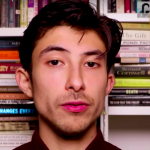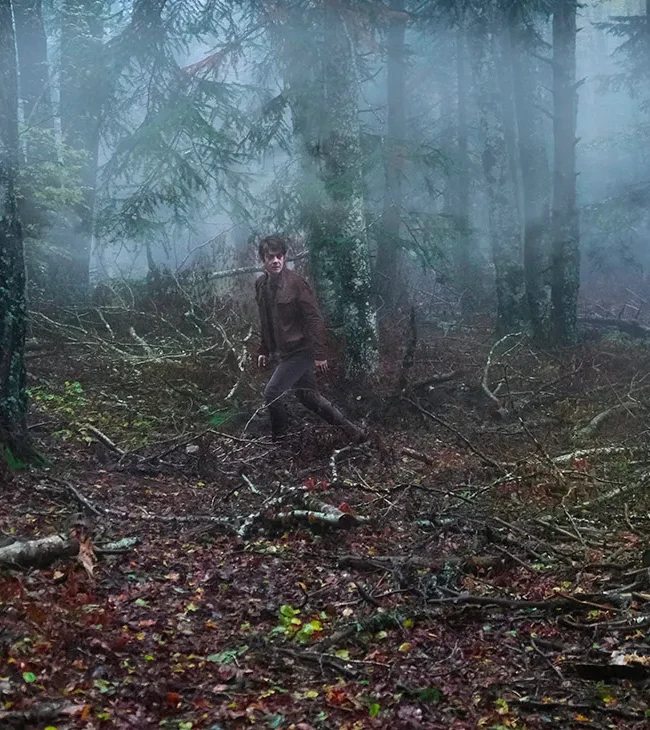A Conversation with the Cast & Crew of ASH

Today I’m stepping into the mysterious world of Ash, the visually striking sci-fi survival horror film now playing in theaters. Directed by acclaimed musician-turned-filmmaker Flying Lotus, this mind-bending experience follows Riya (Eiza González), who awakens on a mysterious planet to find her crew slaughtered, with only the enigmatic Brion (Aaron Paul) arriving to rescue her. What unfolds is a psychological and physical ordeal as they struggle to trust one another while pieces of their fragmented memories slowly return.
I had the opportunity to speak with the film’s creative team, including director/composer Flying Lotus, writer Jonni Remmler, stars Eiza González, Aaron Paul, Kate Elliott, and Beulah Koale, as well as producer Nate Bolotin. From Flying Lotus’s unique directorial style to the intense physical demands placed on the actors, these conversations reveal how a group of artists from diverse backgrounds united in New Zealand to create a vision of isolation, memory, and survival on an alien planet.
Flying Lotus (Director/Composer)
Hammer To Nail: The press notes mention you played music on set, which Aaron Paul found particularly helpful. How did you select specific music to set the tone for different scenes, and did this process inform your composing for the final score?
Flying Lotus: I was always keeping a tab on who was listening to what. I knew Aaron Paul was a big Radiohead fan so then I started to calculate. If he likes Radiohead, then he’s a 90s head, and I just started pulling all these gems from the 90s. That way when Aaron is out there, we get some jams for him and he will be able to get hyped. It was also an opportunity to bring a different energy to a scene. If there is a certain energy or tone I want for a scene, I could play music at that level and it would totally flip the script. All of a sudden, whatever the music was, that was the vibe we were on.
HTN: The film explores memory loss and identity fragmentation. How did your experience navigating between different creative identities (musician, filmmaker, producer) influence your portrayal of these themes?
FL: The biggest thing that I brought to this from my other worlds, was being able and comfortable to communicate ideas, collaborate, compromise as well as getting the most out of the moment with the resources I have. The biggest gift I have learned from all of this is understanding that every day you work on this stuff, is a day you are going to have to compromise.
HTN: I love this introductory sequence so much. It beautifully allows the audience to become enveloped in this world. What was important to you in those first couple minutes?
FL: That was exactly it. I wanted to create something that pulls people in immediately. Right out the gate I needed the audience to think, “What is going on?”
HTN: At the 31 minute mark there is a sequence where Aaron and Eiza speak, the camera sits outside the spaceship at an off center angle, while the neon red glimmers on their faces. I love this composition. What was your thinking?
FL: I love the idea of doing oners and long takes. Trying to get the most out of a moment. It was one of those opportunities where we had built the set, we had everything there. We wanted to take advantage of it and show people we are actually out here doing this. It was a nice composition and it felt like that’s what the scene called for.
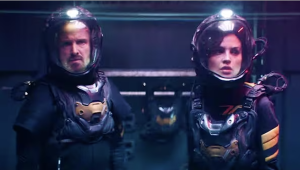
A still from ASH
HTN: At the 39 minute mark, we get this dream sequence with Riya and Kevin. it’s quite striking as she wakes up with sweat all over her face. What was your thinking with this dream sequence?
FL: We wanted to have something that was just completely contrasting. We needed it to be the total opposite. It also had to be a place she wanted to go. We had the most beautiful location available to us in New Zealand. We shot out there for a day, it was so nice to get out of the studio. We were all cooped up on this space station for a month, literally, and now we get to go out into this beautiful forest area, it was awesome.
HTN: Finally, At the 50 minute mark, my favorite moment, which really shows those video game influences, we get this incredible first person fight. What was important to you in depicting it and was that idea originally from the script?
FL: The idea was not in the script, but I wanted to have something of that nature, because a lot of the film, for me, is about perspective. I think there is a very strong video game vibe going on in the material. I felt that day one on the page. I wanted to keep that going as a thread and I am a big first person shooter fan. I think that is such a jarring aesthetic especially if you have been in one world for so long, it can be really fun. I will use it all the time now, it does not matter, it’s part of my tool set now.
HTN: Thank you so much! Such an honor to speak with you. I have been such a fan for so long. Post Requisite is one of my favorite songs of all time.
FL: Hell yeah!
Jonni Remmler (Writer):
HTN: The film centers on characters trying to piece together fragments of who they are. What inspired this core concept of memory and identity?
Jonni Remmler: I had originally written a version of this story that went a more traditional route that had the audience with the crew as things went wrong and their minds were manipulated. It ended up with a final girl type situation. It felt a bit rote and I wanted to find a way to bring a fresh perspective to this kind of story. It was almost a tool to start the story in a fresh place and bring something new to this genre. I wanted to turn the audience’s expectations of how this story should play out upside down on its head.
HTN: How closely did you collaborate with Flying Lotus to ensure the visual and musical elements would enhance the psychological aspects of your screenplay?
JR: Quite a lot. When he came on board we were both very excited to lean in. He wanted to get even deeper into the “mindfuck” direction and I was all for it. There were a lot of discussions of what he was into and what he wanted to highlight. Bringing that to the foreground together was amazing.
HTN: The premise involves characters piecing together fragments of memory. How did the structure of your screenplay reflect or enhance this fragmentation?
JR: Well, it starts with somebody who does not remember. It’s very deliberately structured so that we as an audience are with them and feel their confusion. You look at something like Memento which is doing a similar trickery. It was always the plan to have the audience experience everything as the characters do.
Kate Elliott (Clarke):
HTN: The film deals with isolation and survival on an alien planet. What preparation did you do to convey the psychological strain of this extreme situation?
Kate Elliott: I live in New Zealand haha. I live on a tiny island at the bottom of the world. That is very isolating. Being on this set was pretty isolating though. Being a mother I think also prepared me for this role, it is a real struggle. All in all though, it was pretty easy.
HTN: Working with Flying Lotus, who brings a unique music background to directing – how did his approach differ from other directors you’ve worked with?
KE: It was completely different. That was what attracted me to the project in the first place. Obviously, there was the music on set, but just generally, he has a creative process that I have never worked with before. It was really fun.
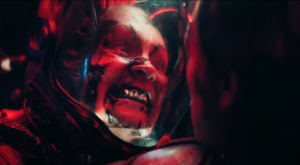
A still from ASH
Aaron Paul (Brion):
HTN: You mentioned being immediately captivated by the script. What specific elements of the story or your character made you “fall in love instantly” with this project?
Aaron Paul: It starts off, and your heart is just pounding the moment you start turning the pages. You saw the film, so you know how it just starts off guns blazing. When the third act came along, I was thinking, “my good god!” It is just insane! Very bloody and gory, but it just messes with your brain constantly. You don’t know what the hell is happening until the very end. Working with Eiza also, she is a dear friend of mine, and it was awesome to be able to chase after something together.
HTN: How did you maintain the psychological intensity required throughout what must have been a demanding shoot?
AP: A lot of screaming. Screaming and crying in the corner. A lot of holding each other up between sobs…but…yeah.
HTN: Hahaha, well Brion seems to exist in a morally ambiguous space. After playing characters with complex ethical journeys in Breaking Bad and Westworld, what new territory did this role allow you to explore?
AP: I got to go to another planet on this one. I had to put myself in the mindset of a guy who has been trapped in this orbital just circling the planet for months alone. It was a very isolating experience, but it was a great one. It was really beautiful.
HTN: I love this intro sequence between you and Eiza. It’s the emotion that comes through strongest in this sequence which in other films could play as mere exposition. What was important to you?
AP: I love that sequence. When things settle down after she attacks my character. They are just trying to figure out what the hell is happening. It is a quieter moment, and to be able to tackle it with her was just so fun.
Beulah Koale (Kevin):
HTN: The press notes mention the tight-knit feeling among the crew. How did the filming environment in New Zealand influence the portrayal of isolation on an alien planet?
Beulah Koale: When you are going over there, the bottom of the world, to shoot a little, American, independent film, you have no choice but to bring the crew together. People are going to feel that camaraderie in the cinema. A lot of this film was practical. I love that and am proud of it.
HTN: How did the music being played on set affect your experience?
BK: I love music so much. It has always been a way for me to get into a zone. Him playing it throughout the shoot really helped.
Eiza González (Riya):
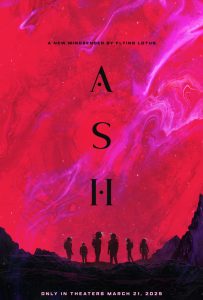
HTN: Working with Aaron Paul, who you’ve been friends with for years – how did that existing relationship influence the complex trust/distrust dynamic between your characters?
Eiza González: It does in both ways. I think that as an actress you are working with an actor who you feel safe with. He is one of my best friends. I can go to him and ask his honest opinion on the work. It was an opportunity for us to go deeper in our friendship as well. I have only hung out with Aaron as my friend and now, I could really see how incredible and professional of an actor he is. Simultaneously, I am playing a character that does not really trust him. In reality, I trust him with my life! I trust him more than I trust myself! Forgetting that and pushing this, “We do not trust each other,” feeling was so crucial for us.
HTN: Flying Lotus created a unique atmosphere by playing music on set. How did this influence your performance, especially in the more intense psychological scenes?
EG: It really did! When you have a visionary that has a real body for what he wants and where he is going it is so much better. You said it perfectly, it is an ambiance and environment that he creates. You step into this mindset and it creates a different energy. It really transported me to this world and to be present with my emotions and character. It was a really amazing experience. The only time I had done something similar was with Baby Driver. On set we were listening to the music because everything was choreographed to that. This was a very immersive experience and I think watching the movie feels similar.
HTN: There’s this incredible and ruthless fight sequence at the 54 minute mark in the shower. Your performance is so visceral at this moment. What was important to you?
EG: Maintain safety first. Take care of Kate! That was the most important thing. She is in a very uncomfortable suit, and it can be very difficult to do action in those conditions. The suit is also so heavy! We are also dealing with water, so you have to keep safety at the forefront. It is a very guttural performance. It is very visceral as you said. Feeling safe allows us to dig deeper into the performance.
Nate Bolotin (Producer):
HTN: How does this fit into the vision for the types of stories XYZ pictures wants to tell?
Nate Bolotin: Working with Flying Lotus has always been a dream. I got introduced to him at Sundance, and when I heard about what he wanted to do in the movie world, it was clear he could fit into our universe as a filmmaker. He was the exact kind of filmmaker we want to work with. He has a visionary approach to it, but still, being a musician and transitioning over to film, that is a real challenge. It’s not easy to do that and we wanted to help. He wanted to make cool genre movies and that was perfect! That was right in our wheelhouse and we immediately started to figure out what we could do together.
HTN: How do you work to protect the space for an artist like Flying Lotus, on a film that is being produced for a lower budget, to avoid compromises and let that vision come through?
NB: That is essentially how we set up all of our films. Everything that we do, we try to control the process ourselves. That is so we can grant that liberty and freedom to the filmmaker. If it is an XYZ movie top to bottom, financing, producing, etc, we can do that! We can just grant that! Being in New Zealand, I was able to personally make sure that happened. I made sure he had what he needed, but of course there were a few moments where I had to be a producer and tell him he could not have something that he wanted. It is a balancing act, but at the end of the day, he got to see his vision through and you can’t have a million cooks in the kitchen overseeing the production and giving notes. It is less efficient that way.
– Jack Schenker (@YUNGOCUPOTIS)




